QuestionI have a new puppy, only 8 weeks old. She is an airedale and very smart, picking up on training quickly. Rarely goes potty in the house except for when she cant hold it, and know what she can and cant chew on and never bites. But when anyone else is around, including a friend who is living here, she will pee on the floor multiple times, tries to chew on everything and bites them (playfully, but it is a behavior I have stopped). I dont know what to do!!
AnswerStart with a clean bill of health from your veterinarian so you know you aren't working with an underlying health issue.
Here's a link to additional information on my web site. http://outlawchinooks.com/articles.html
Good luck and let me know if you have additional questions.
Dog - Potty Training Basics
Going to the bathroom in the house is one of the biggest issues for new puppy owners. You can easily win the battle if you are consistent, patient, use supervision, utilize confinement and reward your pup with scrumptious treats. Remember, you are teaching your puppy where to relieve him or herself rather than where not to relieve him or herself.
One of your first steps is to choose a place that you want your pup to eliminate. Once you have chosen the spot, always take your pup on leash to the spot and stand there for three to five minutes. If you don't have success, take pup back inside and place them in their crate. When you are home, make this trip every hour or two and praise success with voice and treats to expedite the learning process. You pup will quickly learn that elimination bring tasty rewards.
Use a Crate. Most dogs love their "den" as long as it is the right size. If it is too big, part of it will become a bathroom. If it is too small, it is uncomfortable. Your pup should have enough room to stand up, turn around and lay down. When pup is in the crate, provide a food stuffed chew toy like a Kong so pup has something to occupy the confinement time. The crate should help you predict when the pup needs to "go" so you can teach pup where and why it needs to eliminate outdoors.
Outside Time: Puppies need to relieve themselves frequently. Ideally, your pup should go outside every two hours.
Same Time, Same Place: Take pup out on a six-foot leash and stand in the place you want pup to "go." Praise pup for "going" in the right location.
Boo Boo? Show pup his mistake and let him know he was wrong with a firm "No!" Take pup outside and show him how you want it done. (Not literally!)
Don't rub pup's nose in "it" unless you want him to eat "it."
Don't smack him with a rolled up newspaper unless you want him to eat it. If you want to hit something with a newspaper, roll it up and hit yourself for not paying more attention to pup's needs.
Feed to Succeed: A high quality, nutritional, highly digestible diet keeps odors, waste and trips outside to a minimum.
Take pup out:
After eating
After napping
After a play session
First thing in the morning
Last thing at night
When his eyes are crossed
The biggest key to house training success is consistency. The more consistent you are with pup, the quicker pup will give you the desired response. When pup relieves himself outside, pup earns more free time inside your home. One quick method is alternating freedom and confinement.
On a basic level the following guidelines will help you train your puppy:
Follow the house-training schedule strictly. If pup has an accident you have allowed too much freedom.
While standing in one spot with pup on a leash, allow two minutes for relieving himself. Reward immediately (within one second) with a treat or praise after the desired behavior.
Holding "it" all night is the first stage to successful housebreaking.
If your puppy whines and cries at night, please try to ignore the commotion and go back to sleep. (This applies unless pup is hurting itself.) If you get up even to reprimand pup for making noise, you have just shown your pup that you will get up at night. Occasionally dogs must relieve themselves at night, and ignoring will lead to a big mess in the morning. You can respond to the pup's warning by allowing pup out for only two minutes.
For an easy routine to assist in quickly training your pup to "go outside" and avoid most accidents, follow this simple schedule:
In the morning, carry your pup outside and place it on the ground (attached to your leash) that you have designated as the bathroom. Give your command to "go to the bathroom" or "potty" or "tinkle" or some other suitable phrase. Allow two minutes for a response. Gently repeat the command (in a tone of voice like you use with your coworkers) and as soon as pup responds, reward immediately. Remember to bring your reward treat with you no matter how optimistic or pessimistic you feel.
If pup fails to respond within the allotted time, carefully take it inside and place it back in the crate until you are dressed and ready to try again.
When your pup responds correctly, give lots of praise and of course your scrumptious treat. Giving the treat reinforces the desired behavior.
Now pup is going to the bathroom outside and can earn some freedom in your home. The following table shows a suggested daytime schedule.
Goes to the bathroom outside
1/2 hour free time
1-1/2 hours of confinement
This routine continues until pup learns to "go" on command and earns your trust. At that time you can allow more freedom then go to the next level.
Goes to the bathroom outside
1 hour free time
2 hours confinement
This routine continues until pup is doing well. At that time you can allow more freedom.
Goes to the bathroom outside
2 hours free time
2 hours confinement
This entire process may take up to six weeks. Follow the basics covered here and DON'T become discouraged. They are only pups once and we should enjoy all aspects of new companion's lives.
~~~~
Dog - Preventing Puppy Biting and Nipping
Your puppy bites and nips with those needle sharp, vampire-like teeth in order to learn more about their environment. They have been practicing this skill with their litter mates since they were born and they don't understand that humans are not as durable as their fur coated family members. Pups need to learn to inhibit their bite and to be gentle with humans and eventually to not place their teeth on us at all.
Over the years, lots of people have received the advice to flip their pup on his back every time their puppy bites. This is called an alpha roll and was quite popular in the 1970's, but for most people, this is not an effective training tool. Many dogs will react badly to the alpha roll by becoming more aggressive because they now see their humans as being unpredictable, frightening and possibly even as threatening their very existence. Fortunately, there are alternatives to the alpha roll that will help your pup to learn how to have a soft mouth.
If you pup puts his mouth on you in a gentle manner, ignore it. You can teach him that teeth aren't allowed on human skin. What you are teaching now is that any bite contact should be soft. If you are petting pup and you get a bite that hurts, respond in a higher pitched voice with "Ouch" and walk away. If pup follows and continues to bite, you will want to tether pup to a solid object so you can move out of range. Wait 30 to 60 seconds and then interact in a calm fashion with your pup. If you get another hard bite, say "Ouch" and walk away. You are teaching pup that this behavior makes you go away and your clever pup will begin to understand this very quickly.
Every time pup bites hard, say "Ouch" and walk away. If pup mouths you gently, say "Good" and reward with a treat and keep on paying attention or playing with pup. You pup will quickly figure out that being gentle brings treats and continued interaction with you. This method uses the language your dog understands -- pup's littermates cease playing when the bites get too hard, and you are now speaking that same language. Puppies learn a soft mouth from their littermates, and they need 8 weeks with their dog family to understand soft mouth and proper interaction.
Once your puppy has learned the basics of gently mouthing, you can require softer and softer contact to keep playing and interacting with you until there is no mouthing allowed. Once you have taught your puppy that teeth are not acceptable, you will have effectively conditioned pup with good bite inhibition.
Basic Tips
When playing with your puppy, have a soft chew toy available to offer before pup puts teeth on your hand.
If your puppy bites when you are petting, give treats with one hand while petting with the other hand.
Plan your petting sessions when your pup is tired. A tired puppy is a good puppy.
Don't play games that involve face grabbing or pushing pup's head as these encourage biting.
Always supervise puppies and children. Children often do things wrong when a puppy bites like screaming, jumping and running -- all of which encourage inappropriate puppy behavior.

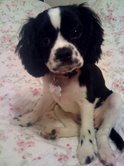 Puppy Yelping
QuestionQUESTION: Hi! I have a 6 month old Cocker
Puppy Yelping
QuestionQUESTION: Hi! I have a 6 month old Cocker
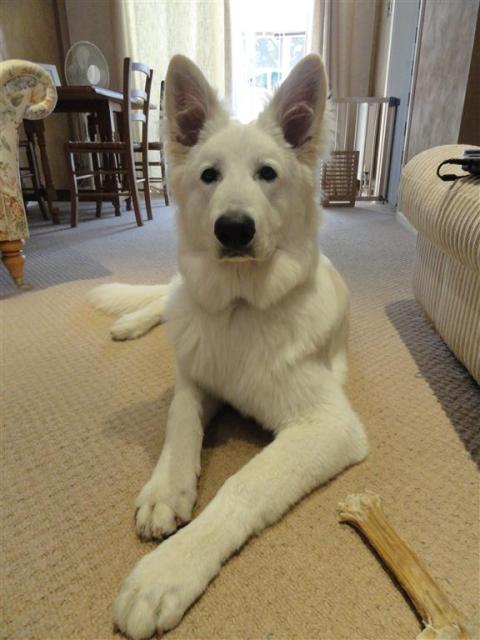 Barking at strangers
Question
Kupe
We have a 7 month old (not neutered) male
Barking at strangers
Question
Kupe
We have a 7 month old (not neutered) male
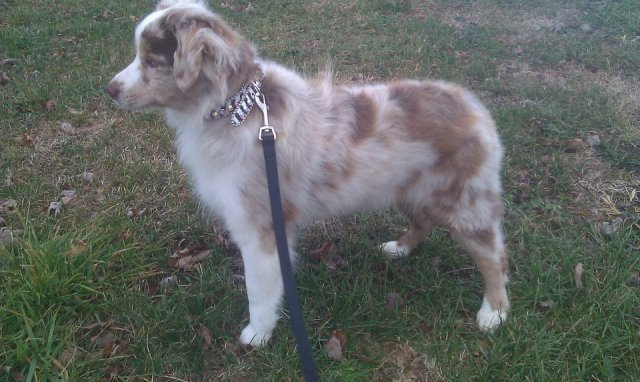 Jumping.
Question
Stetson
I have a 8 month old, male mini
Jumping.
Question
Stetson
I have a 8 month old, male mini
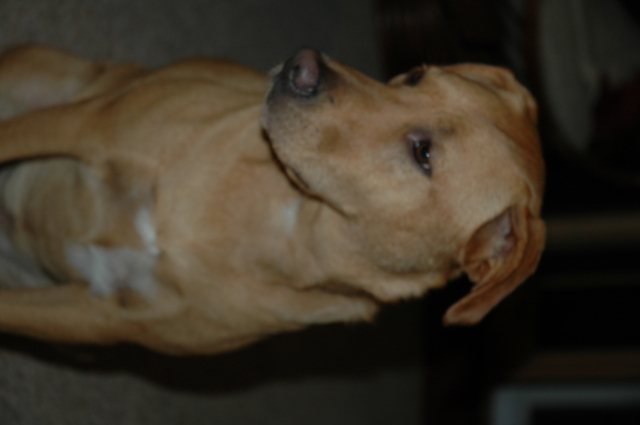 dog distraction/deer carcass
Question
ginger
Our dog is a mutt mostly Rhodesian Ridg
dog distraction/deer carcass
Question
ginger
Our dog is a mutt mostly Rhodesian Ridg
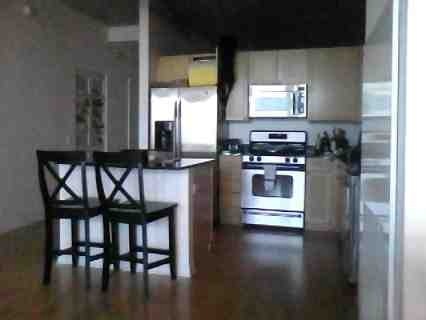 Dog jumps on counters, Refrigerator,cabinet tops when Im not home
Question
Bell
Hello,
I dont even know where to
Dog jumps on counters, Refrigerator,cabinet tops when Im not home
Question
Bell
Hello,
I dont even know where to